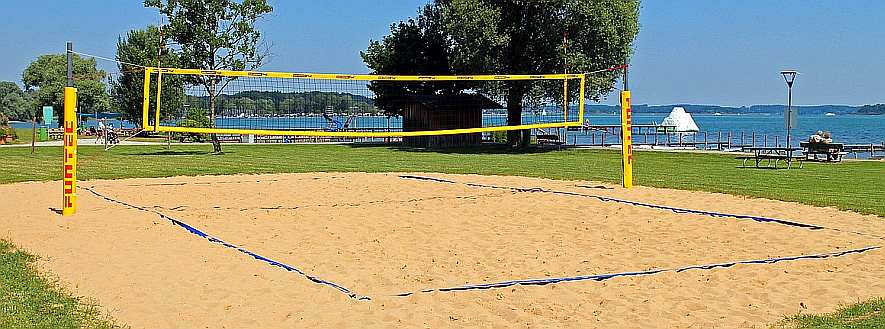|
 |
| |
VOLLEYBALL |
 |
| |
A Dynamic Sport of Teamwork and Skill |
Volleyball is a fast-paced, engaging sport enjoyed by millions of people worldwide. Known for its emphasis on teamwork, strategy, and athleticism, volleyball can be played both competitively and recreationally. Originating in the late 19th century, it has evolved into one of the most popular sports in the world, with indoor, beach, and even grass variations that appeal to players of all skill levels.
Volleyball is more than just a sport; it is a global phenomenon that fosters community, teamwork, and athletic excellence. Whether played indoors, on the beach, or in the backyard, volleyball provides an engaging way to stay fit and have fun. With its rich history and ever-evolving nature, volleyball will continue to captivate players and fans for generations to come. |
| |
The History of Volleyball
The sport was invented in 1895 by William G. Morgan, a YMCA physical education director in Holyoke, Massachusetts. Originally called “Mintonette,” Morgan designed the game to be a combination of basketball, baseball, tennis, and handball, offering a less physically demanding alternative for older YMCA members. It was later renamed “volleyball” due to the primary action of the game—volleying the ball over the net.
The first official volleyball game was played in 1896, and since then, the sport has spread rapidly across the globe. Volleyball made its debut in the Olympic Games in 1964, and since then, it has become one of the premier team sports in the international sporting arena. |
| |
Rules of the Game
Volleyball is played by two teams, with each side consisting of six players on an indoor court or two players in the beach version. The objective is to send the ball over the net to the opponent’s side and prevent them from returning it. A point is scored when the ball touches the ground on the opponent's side or when the opposing team makes an error. Here are some key rules:
- Scoring: Teams play to 25 points, needing to win by at least two points. A match usually consists of the best of five sets.
- Rotations: Players rotate positions each time their team wins a serve, ensuring everyone plays different roles.
- Three Touch Rule: A team has three touches (excluding the block) to return the ball to the opponent’s side.
- Serving: The game begins with a serve from behind the baseline; the ball must cross the net without touching it.
|
| |
Variations of Volleyball
- Indoor Volleyball: Played on a hardcourt with six players per side, this version requires agility and strategic team play.
- Beach Volleyball: Played on sand with two players per team, this variation emphasizes stamina and individual skill due to fewer players.
- Sitting Volleyball: A Paralympic version designed for athletes with disabilities, played on a smaller court with a lower net.
- Grass Volleyball: Played casually on grass, often in recreational or co-ed leagues, with varying team sizes.
|
| |
Skills and Techniques
Volleyball requires a combination of athleticism, teamwork, and strategy. Some essential skills include:
- Serving: Effective serves put pressure on the opponent. Players use either overhand or underhand serves.
- Passing: Also known as a "bump," the forearm pass is used to receive the opponent’s serve and direct the ball to the setter.
- Setting: The setter positions the ball for the hitter, using an overhead pass.
- Hitting/Spiking: Players attempt to send the ball forcefully into the opponent’s court.
- Blocking: A defensive technique used to stop or deflect the opponent's attack.
- Digging: A defensive move to prevent the ball from hitting the ground after a powerful spike.
|
| |
Strategy and Teamwork
A well-coordinated volleyball team uses effective strategies to outplay opponents. Common tactics include:
- Quick Sets: Fast passes between the setter and hitter to catch the opposing blockers off guard.
- Decoy Plays: Using fake movements to mislead the opponents.
- Formations: Teams often employ 5-1 or 6-2 rotations to optimize setting and attacking capabilities.
|
| |
The Impact of Volleyball on Health and Fitness
Playing volleyball offers a variety of physical and mental benefits, including:
- Cardiovascular Fitness: The continuous movement involved in volleyball improves stamina.
- Muscle Strength: Jumping and spiking strengthen leg and upper body muscles.
- Coordination and Reflexes: The fast-paced nature of the game enhances hand-eye coordination.
- Mental Benefits: The teamwork and strategy involved promote communication, leadership, and stress relief.
|
| |
Volleyball Around the World
Volleyball enjoys immense popularity in countries like Brazil, the United States, Russia, and Japan. The Fédération Internationale de Volleyball (FIVB) governs the sport internationally, organizing tournaments like the World Championships and the Volleyball Nations League. Beach volleyball has also gained prominence, with its own professional circuits and events, including the Summer Olympics. |
| |
|
|
| Shopping Listing Title & Link |
|
Listing Description |
| |
| Shopping Listing Title & Link |
| |
Listing Dscription |
| |
|
| |
|
| Shopping Listing Title & Link |
| |
Listing Description |
| |
|
| Shopping Listing Title & Link |
| |
Listing Description |
| |
|
|
| |
|
| |
 |
|
 |
|
|